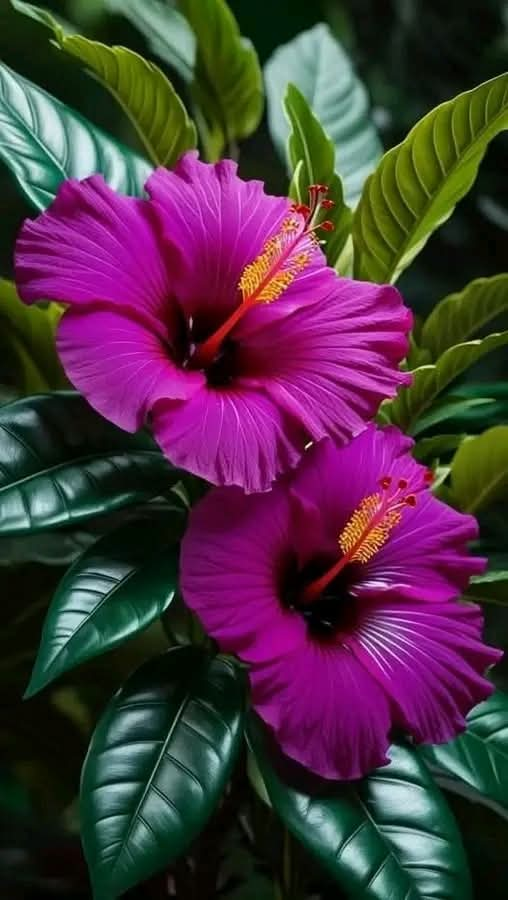The purple hibiscus is a breathtaking flower that captivates with its vivid purple petals, deep magenta center, and striking yellow stamens. Its lush green leaves and elegant blooms create a stunning contrast, making it a standout in any garden. The hibiscus is known for its tropical charm, long blooming season, and symbolic significance. Whether grown in a backyard, displayed in floral arrangements, or admired in nature, this exotic flower radiates beauty and grace.
In this article, we’ll explore why the purple hibiscus is special, how to care for it, its symbolism, and creative ways to enjoy this magnificent bloom.
What Makes the Purple Hibiscus Special?
The hibiscus genus (Hibiscus spp.) includes hundreds of species, ranging from classic red and pink varieties to rarer hues like blue, white, and purple. Among them, the purple hibiscus holds a unique appeal due to its rich color and tropical elegance.
Here’s why this flower stands out:
✔ Striking Appearance – The deep purple petals with a dark center create a mesmerizing contrast.
✔ Lush Green Foliage – The glossy leaves enhance the flower’s beauty.
✔ Extended Blooming Season – It flowers from spring through fall, providing lasting beauty.
✔ Attracts Pollinators – Bees, butterflies, and hummingbirds love its nectar-rich blooms.
✔ Symbolic Meaning – The purple hibiscus represents mystery, transformation, and elegance.
Whether planted in gardens, potted on patios, or used in bouquets, the purple hibiscus adds a touch of the exotic to any setting.
Caring for Purple Hibiscus
If you want to grow and maintain a thriving purple hibiscus, proper care is essential. Here’s a step-by-step guide to help your plant flourish:
Light Requirements
☀️ Hibiscus thrives in full sun (6–8 hours of direct sunlight per day).
☁️ In hot climates, partial shade during peak afternoon hours prevents leaf scorch.
Watering Needs
💧 Keep the soil evenly moist but not waterlogged. Water 2–3 times a week, adjusting based on weather conditions.
🌿 Use well-draining soil to prevent root rot.
Soil & Fertilization
🌱 Hibiscus prefers rich, well-draining soil with a slightly acidic pH (6.0–6.5).
🌿 Apply a balanced fertilizer (10-10-10) every 2–3 weeks during the growing season.
Temperature & Humidity
🌡️ Ideal temperatures: 65–85°F (18–29°C).
💦 Thrives in moderate to high humidity; misting helps in dry climates.
Pruning & Maintenance
✂️ Light pruning after flowering encourages new growth and more blooms.
🚫 Remove damaged or diseased leaves to maintain plant health.
Following these guidelines will help your purple hibiscus remain healthy and vibrant throughout the season.
Symbolism of the Purple Hibiscus
Flowers have long held deep meanings, and the purple hibiscus is no exception. This unique bloom symbolizes:
✨ Mystery & Intrigue – The deep purple hue reflects enchantment and fascination.
💜 Elegance & Nobility – Purple has been associated with royalty, grace, and sophistication for centuries.
🌺 Transformation & Growth – As a resilient tropical plant, it represents renewal and change.
In many cultures, gifting a purple hibiscus expresses admiration, respect, and deep affection.
Creative Ways to Enjoy Purple Hibiscus
Looking for ways to incorporate this beautiful flower into your life? Here are some ideas:
✅ Garden Centerpiece – Plant purple hibiscus as a focal point in your landscape.
✅ Container Gardening – Grow it in large pots for balconies, patios, or indoor spaces.
✅ Floral Arrangements – Freshly cut hibiscus flowers add a touch of luxury to bouquets.
✅ Hibiscus Tea – Some hibiscus species are used to make herbal tea, rich in antioxidants.
✅ Photography & Art – Capture its beauty in paintings, photographs, and home décor.
By integrating purple hibiscus into your space, you can enjoy its beauty, fragrance, and symbolic power year-round.
Final Thoughts
The purple hibiscus is more than just a flower—it’s a symbol of mystery, elegance, and transformation. Its stunning blooms, easy maintenance, and cultural significance make it a prized addition to gardens and floral displays. Whether you’re an experienced gardener or a flower enthusiast, the purple hibiscus is a must-have for those who appreciate tropical beauty.
Would you consider planting a purple hibiscus in your garden? Share your thoughts in the comments below! 🌸💜
More Recipes You Might Like
-
Texas Toast Sloppy Joes: The Crunchy, Cheesy Upgrade You Didn’t Know You Needed
There’s something timeless about sloppy joes. For generations, this saucy, savory, and slightly sweet ground beef sandwich has been a go-to comfort food in American kitchens. It’s quick, filling, and family-friendly—perfect for busy weeknights. But what if we told you there’s a way to take this classic dish up a notch? Enter the Texas Toast…
-
Classic Pig Pickin’ Cake
When it comes to Southern desserts, few sweets shine as brightly as the Classic Pig Pickin’ Cake. This nostalgic cake, sometimes called a “Mandarin Orange Cake,” has roots deep in Southern tradition. It gets its playful name from its frequent appearance at pig pickin’s—Southern-style barbecue gatherings where communities come together to enjoy slow-cooked pork, sides,…
-
Lemon Garlic Butter Chicken with Creamy Parmesan Pasta
There’s something irresistible about the combination of tender, golden-browned chicken paired with a creamy pasta coated in Parmesan cheese. Add the brightness of lemon, the depth of garlic, and the richness of butter, and you have a recipe that feels indulgent yet approachable enough for a weeknight dinner. Lemon Garlic Butter Chicken with Creamy Parmesan…



